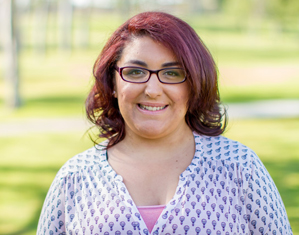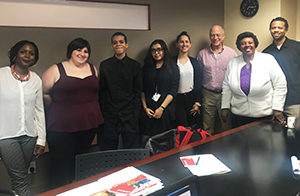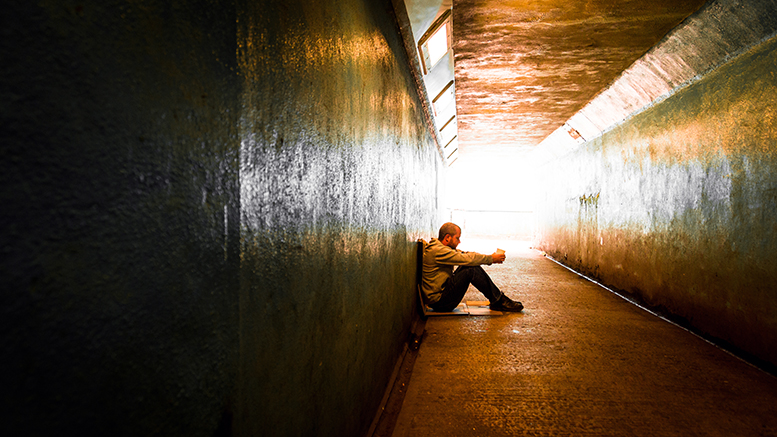Angel Woods, a 26-year-old recovering addict, plans to enroll in a nursing program in San Diego City College in California after completing a parent education and child development course at the San Diego Rescue Mission.
Woods, who had tried college before, hopes to change her life so she can better care for her 4-year-old daughter.
“It’s very beneficial for parents trying to have more healthy, positive parenting skills,” she says.
The parenting course, offered by the San Diego Community College District’s (SDCCD) Continuing Education Department (SDCE), is part of a newly formed partnership between SDCE and the Rescue Mission, which serves at-risk populations, including the homeless.
SDCE this spring started providing free non-credit courses on completing a high school equivalency credential, as well as parenting at the Rescue Mission.
Reaching vulnerable populations
There are about a dozen students in each class, says SDCE spokesperson Ranessa Ashton. The classes are open to anyone who lives at the mission’s shelter or is a client at its other programs. Students’ ages range from the 20s to the 50s.
“Community colleges are designed to serve the most vulnerable populations,” says SDCE President Carlos Turner Cortez, and this program aligns with the college’s mission to promote social justice and equity. He prefers the term “individuals with housing security issues,” because it includes people living in basements with their family and parents with children in motels, as well as people living on the street.
“It’s been a long-time goal of the adult education division to connect with students where they’re at,” Ashton says. College officials knew they weren’t serving the homeless population well enough, but they hope the partnership with the Rescue Mission will be a good fit because it’s close to one the district’s campuses and has classroom space.
“If the students complete a GED, that’s a major first step in their education,” Ashton says. Next year, the mission plans to make a high school equivalency class mandatory for anyone in its year-long residential program.

Angel Woods hopes to make a better life for herself and her daughter through college. (Photo: San Diego Community College District)
The Rescue Mission has an industrial kitchen, so SDCE is planning to expand its offerings at the shelter next year to include culinary arts. Future programs could include training for office assistants/front desk administrators and accounting technicians.
The goal for SDCE is to encourage students who complete those classes to enroll in credit or non-credit job training programs at one of the district’s colleges.
In addition, in response to increasing numbers of students with “vulnerable housing situations,” Ashton says, SDCE is working on setting up food pantries and clothing exchanges at its Mid-City Campus and Educational Culture Complex. (A University of Wisconsin study published in March found a third of community college students nationwide have food insecurity issues, and 14 percent lack secure housing.)
The San Diego district is also starting a partnership with the Monarch School, a K-12 public school that serves homeless students. SDCCD has a campus next door that provides parent education, GED and English-as-a-second-language courses. It also has hosted information sessions and tours for that population, Cortez says.
Further partnership opportunities are in discussions, Ashton adds. The goal would be to get Monarch students and clients of the Rescue Mission to enroll in the community college with free tuition via the San Diego Promise.
During the first year of the San Diego Promise, 200 students participated, including 25 in continuing education (CE). Those CE students had a 93 percent retention rate and average GPA of 3.06, Ashton says. Later this month, the college will select 600 students for the second year of the program, including 75 in CE.
Job training
The Montgomery County Homeless Coalition, a nonprofit organization in Texas, secured a large building formerly occupied by a food bank with the idea of bringing in a variety of nonprofits to provide job training and wraparound services.
“They reached out to us to see if we would be interested in offering a workforce program,” and we agreed to participate, says Linda Head, associate vice chancellor for workforce education and corporate partnerships at Lone Star College.
Because the building has a large kitchen and is in a Houston suburb with many restaurants, the Lone Star decided to use it to train about 40 homeless people as line cooks and sous chefs. For now, it’s a certificate program, but Head hopes it will eventually expand to include a culinary arts associate degree. Some of the students will start with noncredit courses to help them secure a high school equivalency credential.
Lone Star plans to do recruiting and advising in the fall, with the first classes to start in January, Head says. Other organizations housed in the building will provide funds to help the students with such needs as childcare, food and utilities. A Lone Star employee based at the center provide career navigation and advising.
The program is aimed at training homeless people who probably haven’t thought about enrolling in college, rather than current Lone Star students who happen to be homeless. It’s part of the college’s effort to boost enrollment and help with completion and retention. “The plan is to get to know members of the community we might not have reached before,” says Head.
The community college and the Homeless Coalition are part of a larger initiative, called E3 = Equip, Educate, Empower, that targets lower-income families and individuals who have the motivation and potential to improve their lives. The initiative coordinates a range of services and strategies from nonprofits, government, faith-based organizations and community groups.
According to Head, this initiative fits in with the Lone Star’s mission “to build strong partnerships to promote student and community success.”
A path to college
In New York City, the Partnership for the Homeless recently started working with Guttman Community College, LaGuardia Community College and the Borough of Manhattan Community College.
The goal is to help clients build long-term careers, says Mario McMichael, director of the partnership’s Economic Opportunities Program (EOP), which hosts a career readiness course aimed at formerly homeless unemployed and underemployed single mothers. EOP also provides internships and mentoring opportunities.
“We provide various levels of support to make the transition from a high school diploma or GED to postsecondary education a little smoother,” McMichael says.

Students from Guttman Community College in New York City visit with staff at the Partnership for the Homeless. (Photo: Partnership for the Homeless)
“Stella and Charles Guttman Community College is thrilled about our launch of a pilot collaboration with the Partnership for the Homeless as we both share a similar philosophy and commitment to helping young people rise from poverty to economic self-determination,” says Valoria Blackson, director of the college’s Office of Partnerships & Community Engagement.
That office has agreed to contribute to the curriculum design of career readiness and soft skills courses, co-teach several classes, and allow the program to be housed at Guttman to expose students to an educational environment, Blackson says. Exposure to Guttman has already resulted in one EOP student applying for admission.
Depending on clients’ needs, EOP helps with financial and childcare issues and “mapping out an education process,” McMichael says, including a plan to repay student loans in default and apply for scholarships.
During the partnership’s first year, he expects about a dozen students will enter college and get on a path to economic success.
The partnership’s education coordinator teams with college advisors to work out such issues as ensuring students who receive education loans don’t lose their housing vouchers. New York City counts loans received for extra educational expenses beyond tuition, such as books, as income. That can jeopardize eligibility for housing vouchers, so students are encouraged to turn down those loans.
The partnership with Guttman started when a group of students visited EOP to engage in conversations with the staff about homelessness, how the program supports at-risk families and how different populations’ view the American Dream.
Some of the students were first-generation Americans who had the perspective that anyone can pull themselves up by the bootstraps and attain success, McMichael says. They learned that other people have a different perspective, and that led to deeper conversations about discrimination and equity – and that all groups don’t have the same access to the American Dream.

